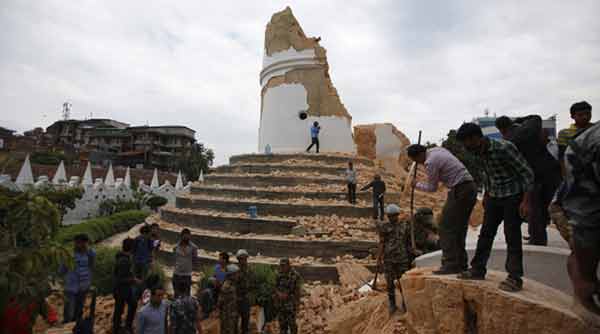
Kathmandu, Nepal (BBN)-At least 3,218 people are now known to have died in a massive earthquake which hit Nepal on Saturday, say officials.
Rameshwor Dangal, head of Nepal's disaster management agency, said another 6,500 people had been injured, reports BBC.
Dozens of people are also reported to have been killed in neighbouring China and India.
Thousands have spent a second night outside after the 7.8-magnitude quake, which also triggered deadly avalanches on Mount Everest.
Vast tent cities have sprung up in Nepal's capital, Kathmandu, for those displaced or afraid to return to their homes as strong aftershocks continue.
Rescue missions and aid have started arriving to help cope with the aftermath of the worst earthquake to hit Nepal for more than 80 years.
Efforts to dig victims out from under the rubble of collapsed buildings in Kathmandu continued throughout Sunday night.
Meanwhile, officials have warned that the number of casualties could rise as rescue teams reach remote mountainous areas of western Nepal.
Initial reports suggest that many communities- especially those close to mountainsides- suffered significant quake damage.
Landslides have prevented rescue teams from reaching rural communities in the area where the quake was centred, chief Gorkha region district official Prakash Subedi said.
"Villages like this are routinely affected by landslides, and it's not uncommon for entire villages of 200, 300, up to 1,000 people to be completely buried by rock falls," World Vision spokesman Matt Darvas said. "It will likely be helicopter access only."
A man evacuated by helicopter to Pokhara, 200km from Kathmandu, said almost every home in his village of more than 1,000 houses had been destroyed, charity worker Matt Darvas of World Vision told the BBC.
In Dhading district, 80km west of Kathmandu, people were camped in the open, the hospital was overflowing, the power was off and shops were closed, Reuters news agency reported.
RENEWED PANIC
A powerful aftershock was felt on Sunday in Nepal, India and Bangladesh, and more avalanches were reported near Everest.
The 6.7-magnitude tremor, centred 60km (40 miles) east of Kathmandu, sent people running in panic for open ground in the city.
It brought down some houses that had been damaged in the initial quake.
At hospitals rattled by the aftershocks, staff moved sick and injured patients outside on Sunday afternoon.
Both private and government hospitals have run out of space and are treating patients outside, officials say.
STRANDED ON EVEREST
Foreign climbers and their Nepalese guides around Mt Everest were caught by the tremors and a huge avalanche that buried part of the base camp in snow.
More than 60 people were injured and many people are still missing.
Separately rescue workers have told the BBC that climbers stranded on Everest have been unable to get down because climbing ropes and ladders have been swept away by a series of avalanches.
Tourism Minister Deepak Chanda Amatya told the BBC that more than 50 climbers had been rescued.
There are 14 international medical teams on the way to Nepal, the UN says, and up to 15 international search-and-rescue teams on the way, the UN says, which will if necessary use military aircraft or the overland route from India to get into Nepal.
Offers of help have come in from around the world. Some foreign teams have already arrived and are helping with search and rescue efforts - braving aftershocks at Kathmandu airport that forced some aircraft to circle before landing.
The UN children's agency says nearly one million children in Nepal urgently need humanitarian assistance as they were particularly vulnerable.
The country is running out of water and food, and there are frequent power cuts, the UN says.
Heavy rain earlier on Saturday further worsened conditions with UN officials expressing concern that thunderstorms that could harm people staying outdoors and lead to a shortage of vaccines against disease including diarrhoea and measles.
OFFERS OF AID
US: Disaster response team and an initial $1m (£0.7m), according to aid agency USAid
CHINA: Rescue team reported to have arrived in Nepal
INDIA: Several aircraft, carrying medical supplies and a mobile hospital, and a 40-strong disaster response team, including rescuers with dogs
UK: Eight-strong humanitarian team, £5m in aid
PAKISTAN: Four C-130 aircraft carrying a 30-bed field hospital, and army doctors and specialists; urban search-and-rescue teams equipped with radars and sniffer dogs; food items, including 2,000 meals, 200 tents and 600 blankets
NORWAY: $3.9m (£2.5m) in humanitarian assistance
Pledges from Germany, Spain, France, Israel and the EU